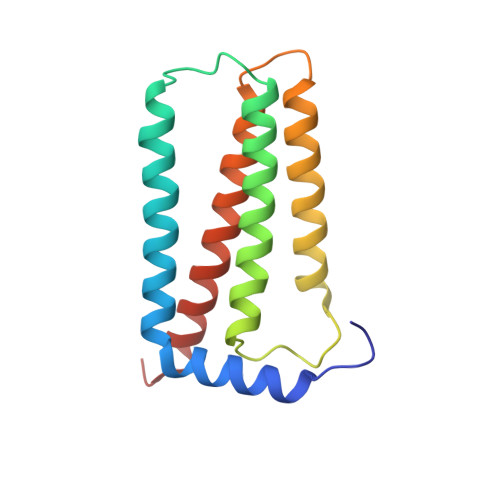Nuclear Magnetic Resonance Solution Structure and Functional Behavior of the Human Proton Channel.
Bayrhuber, M., Maslennikov, I., Kwiatkowski, W., Sobol, A., Wierschem, C., Eichmann, C., Frey, L., Riek, R.(2019) Biochemistry 58: 4017-4027
- PubMed: 31365236
- DOI: https://doi.org/10.1021/acs.biochem.9b00471
- Primary Citation of Related Structures:
5OQK - PubMed Abstract:
The human voltage-gated proton channel [Hv1 (1) or VSDO (2) ] plays an important role in the human innate immune system. Its structure differs considerably from those of other cation channels. It is built solely of a voltage-sensing domain and thus lacks the central pore domain, which is essential for other cation channels. Here, we determined the solution structure of an N- and C-terminally truncated human Hv1 (Δ-Hv1) in the resting state by nuclear magnetic resonance (NMR) spectroscopy. Δ-Hv1 comprises the typical voltage-sensing antiparallel four-helix bundle (S1-S4) preceded by an amphipathic helix (S0). The solution structure corresponds to an intermediate state between resting and activated forms of voltage-sensing domains. Furthermore, Zn 2+ -induced closing of proton channel Δ-Hv1 was studied with two-dimensional NMR spectroscopy, which showed that characteristic large scale dynamics of open Δ-Hv1 are absent in the closed state of the channel. Additionally, pH titration studies demonstrated that a higher H + concentration is required for the protonation of side chains in the Zn 2+ -induced closed state than in the open state. These observations demonstrate both structural and dynamical changes involved in the process of voltage gating of the Hv1 channel and, in the future, may help to explain the unique properties of unidirectional conductance and the exceptional ion selectivity of the channel.
- Laboratory of Physical Chemistry , ETH Zürich , Wolfgang-Pauli-Strasse 10 , 8093 Zürich , Switzerland.
Organizational Affiliation:
















